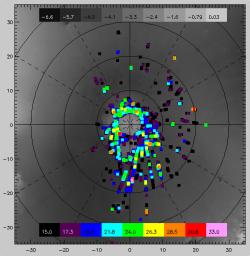
|
Slab Ice and Snow Flurries in the Mars Northern Polar Night
- Click the image above for a larger view
- Full-Res JPEG (516 x 529) (46.4 kB)
- Full-Res TIFF (516 x 529) (102.1 kB)
Caption:
In the 1970s, spacecraft observations of the polar regions of Mars revealed polar brightness temperatures that were significantly below the expected kinetic temperatures for CO_2 sublimation. For the past few decades, we have speculated as to the nature of these Martian polar cold spots. Are the cold spots surface or atmospheric effects? Do the cold spots behave as blackbodies, or do they have emissivities less than unity? Two developments have allowed us to answer these questions: (1) the measurement of the optical constants of CO_2 by Gary Hansen (1997) and (2) direct thermal spectroscopy of the north polar cap by MGS TES (Kieffer et al., 1998).
With a few possible excepts, cold spots are surface effects. The CO_2 frost in cold regions of the polar cap show a strong absorption feature at 25 microns that is indicative of fine-grained CO_2, thus explaining the low brightness temperatures observed by the Viking IRTM. Brightness temperatures at 18 microns are usually consistent with expected kinetic surface temperatures. In many cases, the brightness temperatures at 15 microns reveals an atmosphere that is too warm for CO_2 condensation to occur.
Cold spot formation is strongly dependent on topography, forming preferentially near craters and on slopes of the perennial cap. While cold spots are surface effects, the formation of the fine-grained CO_2 deposits is not entirely restricted to surface formation. TES data, combined with MOLA cloud data (Ivanov and Muhleman, 1999), suggest that at least a few of these cold spots were formed from atmospheric condensates.
Another major component to the north polar cap composition is slab CO_2 ice. Slab ice has near unity spectral emissivity (Kieffer et al.,1999; Hansen, 1998) and appears to have a low albedo. Two explanations for the low albedo are that the slab ice is intrinsically dark or the slab ice is transparent and we are seeing through to the underlying substrate. Regions of the cap where T_18-T_25 < 5degrees have slab ice. Slab ice is the dominant end member of the polar cap at latitudes south of the polar night.
Cataloging Keywords:
| Name | Value | Additional Values |
|---|---|---|
| Target | Mars | |
| System | ||
| Target Type | Planet | |
| Mission | Mars Global Surveyor (MGS) | Viking |
| Instrument Host | Mars Global Surveyor | |
| Host Type | Orbiter | |
| Instrument | Thermal Emission Spectrometer (TES) | |
| Detector | ||
| Extra Keywords | Atmosphere, Color, Crater, Infrared, Thermal | |
| Acquisition Date | ||
| Release Date | 1999-09-18 | |
| Date in Caption | ||
| Image Credit | NASA/JPL/USGS Flagstaff | |
| Source | photojournal.jpl.nasa.gov/catalog/PIA02328 | |
| Identifier | PIA02328 | |
